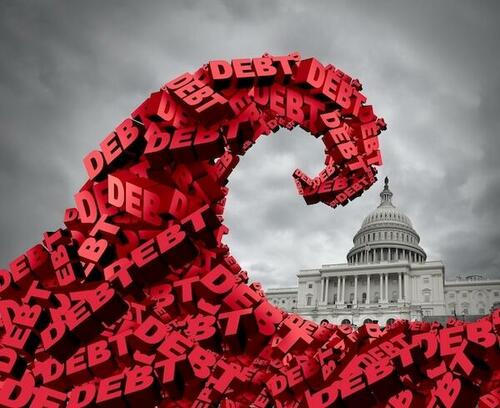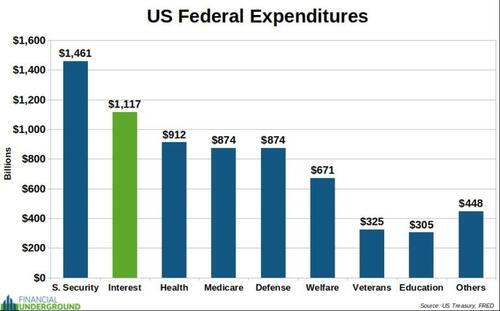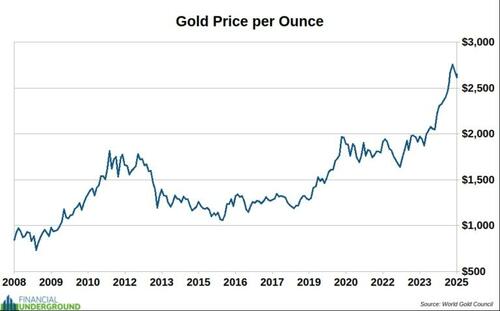2025: The Year The Federal Debt Bubble Bursts
Authored by Nick Giambruno via InternationalMan.com,
I expect 2025 to be a year of profound transformation, where old paradigms are rendered obsolete.
While nothing is certain, I think we can count on radical changes in 2025.
Navigating new paradigms in finance, geopolitics, and energy will be crucial for investors.
A primary focus in my research is to put together the pieces to reveal the true Big Picture and get positioned in unstoppable investment trends ahead of the crowd with smart speculations.
I’m more interested in getting the Big Picture right than gambling on short-term trades in rigged markets.
Understanding the Big Picture has always been essential. But given the scale of changes looming, I can’t think of another year in living memory where it will be more critical than in 2025.
Of particular importance is the US governments financial situation, which has been gradually deteriorating for decades. It’s not surprising that many people are complacent. They’ve long heard about the debt problem, and nothing has happened.
However, I think there’s an excellent chance that 2025 could be the year we see a paradigm shift, shattering conventional mental and financial models for the federal debt.
A crucial tipping point was reached in 2024 when the interest expense on the federal debt exceeded the defense budget for the first time. It’s on track to exceed Social Security and become the BIGGEST item in the federal budget.
Historian Niall Ferguson summed it up nicely:
“Any great power that spends more on debt service (interest payments on the national debt) than on defense will not stay great for very long.
True of Habsburg Spain, true of ancien régime France, true of the Ottoman Empire, true of the British Empire, this law is about to be put to the test by the US beginning this very year.”
The US government will soon have to choose to:
-
Cut defense spending amid the most chaotic geopolitical period since WW2.
-
Default on its promises regarding Social Security, Medicare, Veterans’ Benefits, and welfare generally.
Though it may try, the US government cannot continue to pay for entitlements and defense even if their current levels stay flat into the future. But they won’t stay flat. Both are set to grow significantly in the years ahead.
Tens of millions of Baby Boomers—about 22% of the population—will enter retirement in the coming years. Cutting Social Security and Medicare is a sure way to lose an election.
With the most precarious geopolitical situation since World War 2, defense spending is unlikely to be cut. Instead, defense spending is all but certain to increase.
Former Secretary of Defense Robert Gates recently said: “Barely staying even with inflation or worse is wholly inadequate. Significant additional resources for defense are necessary and urgent.”
In short, efforts to reduce expenditures will be meaningless unless it becomes politically acceptable to make chainsaw-like cuts to entitlements, national defense, and welfare while reducing the national debt to lower the interest cost.
In other words, the US would need a leader who—at a minimum—returns the federal government to a limited Constitutional Republic, closes the 128 military bases abroad, ends entitlements, kills the welfare state, and repays a large portion of the national debt.
However, that’s a completely unrealistic fantasy. It would be foolish to bet on that happening.
That’s why Elon Musk and DOGE are being set up for failure.
The Bottom Line
The government cannot even slow the spending growth rate, let alone cut it.
Expenditures have nowhere to go but up—way up.
The most likely outcome is that the US will try to have its cake and eat it too by paying for both growing defense and domestic obligations via currency debasement.
That’s why I’m confident that ever-increasing currency debasement is the inevitable outcome of the US government’s debt spiral.
It’s a self-perpetuating doom loop from which they cannot escape.
It’s like being on a runaway train with no brakes.
I suspect 2025 will be the year this becomes evident as previous mainstream conceptions about the national debt collapse.
-
“We owe it to ourselves.”
-
“Deficits don’t matter.”
-
“Treasuries are risk-free return.”
-
“The national debt is sustainable as long as we can print money.”
-
“The US will never default.”
These have long been ridiculous tropes that many investors believed.
2025 could be the year the people who believe this nonsense receive a harsh reality check.
As this trend unfolds, I expect the rate of debasement will far exceed the nominal yield that Treasuries and most other bonds will offer.
That means people will look for alternatives to park their savings to preserve their purchasing power.
Instead of parking their savings in Treasuries, I believe people, companies, and countries will increasingly park their savings in gold. It’s already happening in a big way.
While this megatrend is already well underway, I believe the most significant gains in precious metals are still ahead.
Holding physical gold bullion in a private non-bank vault in a wealth-friendly jurisdiction like Singapore, Switzerland, or the Cayman Islands is a good idea.
That’s why I just released an urgent new PDF report with all the details. Click here to download it now.
Tyler Durden
Tue, 01/14/2025 – 18:25







Share This Article
Choose Your Platform: Facebook Twitter Linkedin